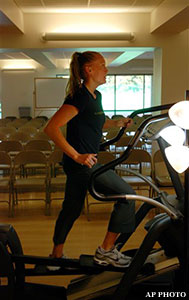
The minute your workout starts to intensify, the temptation is always there: grab the rails.
Whether you're on a stair climber, elliptical or treadmill, reaching out for those support bars can undermine your workout in ways you probably don't realize.
It may seem harmless to get your balance or hold yourself up a little, but it's very easy to support half your weight without really trying that hard. And on a stair climber, for example, supporting half your weight with your arms can cut into your calorie burn by as much as 35 percent, according to Zack Barksdale, a professional fitness trainer at Cooper Aerobics in Dallas, Tex.
And as counterproductive as those lost calories are, Barksdale, who holds a Masters of Science from Baylor University, says the long-term effects are much worse.
"The bad thing about it is that you're not activating your core," he says. "You're not working on posture if you're holding on, and you're not engaging your muscles naturally."
That doesn't just risk your cardio development. It might risk injury.
"Later on down the road," Barksdale says, "if you fall during any kind of physical activity, your shoulders aren't going to have the range of motion to safely catch you. You'll end up doing things like tearing your rotator cuff."
Generally, Barksdale says it's best to avoid the stationary machines if you can and get outside or to an indoor track.
Instead of pushing down steps on a stair climber, you could be pushing your body weight up on stadium steps, which is a much more natural motion. It will also ensure your core is engaged, since there will be no rails to support your body weight as you go up.
But if the gym is a daily stop, and the machines are a part of the routine, there are some things you can do to maximize your time on them.
First and foremost: don't reach for the rails.
"If you don't hold on, your neurological system is going to have to fire like crazy, which will give you better balance and reflexes for life," Barksdale says. "If you’re holding on to railings, as you get older, your balance is going to start to go. We see it all the time."
Also don't think that just because you're holding railings or poles that move with the motion of the machine, that you’re not doing harm.
"You're moving your feet forward and backward, but if you're holding on to handles that move as well, it will make your lower back tighter and tighter every day," Barksdale says.
The fix? Go slow and engage your arms and core into the motion of the exercise to promote balance and strength. Too often, gym-goers amp up the speed on their machine and have no choice but to grab the rails for balance.
"If you're going so fast that you're having trouble staying up without holding the railings, that tells you that your core isn’t strong enough to go that quickly, and you need to work on that first before you start going so fast that you need to grab the railings," Barksdale said. "It's better to start off slow, and be able to balance."
It may be difficult at first, but the benefits will pay off in minutes, as well as days, weeks, months and years.
"The great thing is you're not going to have to work out for an hour," Barksdale says. "You'll get a good workout if you do it correctly for a shorter period of time."
And at the very least, if you have to hold on at some point, make sure there's no tension in your arms, back and traps. The same is especially true for when you're not holding on. The functions and movements of the machines are mechanical, but that doesn't mean your body should mimic the stiffness. Stay loose, and you'll avoid a lot of long-term damage.
And you'll see the short-term gain much sooner.
More Great Stories On ThePostGame:
-- Are You Exercising Too Hard?
-- Celebrating 11-11-11: Top 11 Athletes To Wear No. 11
-- 'Magic Johnson Is HIV Positive:' 20 Years Later, The Man Still Looms Larger Than The Moment
-- Years Before Penn State, Red Sox Had Sex Abuse Scandal




